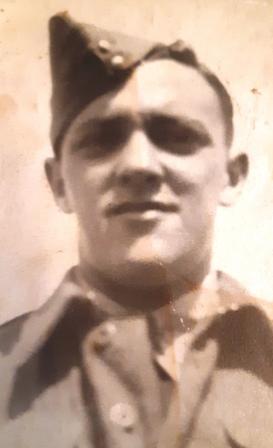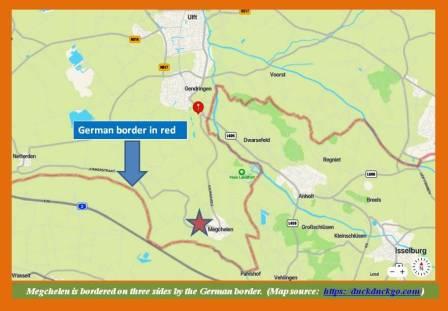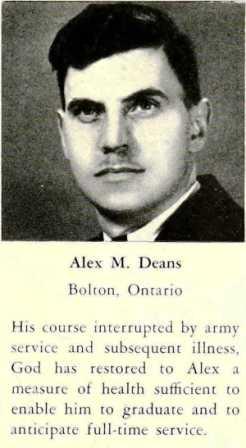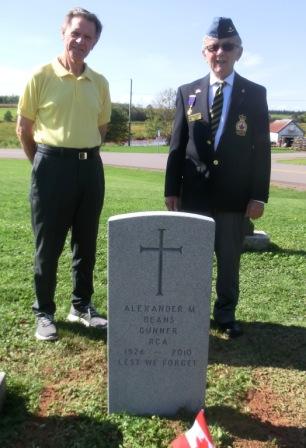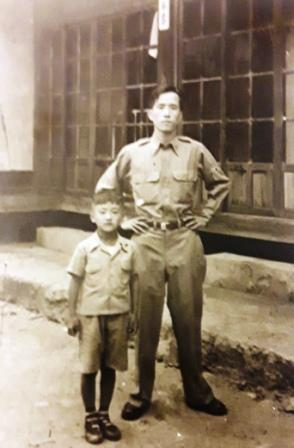October 20, 2021. Recently, we heard from Jim MacFarlane of Fernwood, Prince Edward Island. “ … I have been reading with interest your war time stories and thought you may be interested in my family’s participation in the Second World War. My father, as well as my two oldest brothers, all served in the war at that same time. All are now deceased…”
Jim went on to explain that “…My father, Herman, was an LAC in the air force and my oldest brother, F/L Lorne, was a Mitchell bomber pilot who flew 40 missions overseas. My second oldest brother George was in the navy and was just about to be shipped overseas when the ended…” LAC refers to ‘leading aircraft man’ and Herman, an air engine mechanic, was stationed at the air base in Summerside.
F/L refers to Flight Lieutenant. We visited Jim and his wife Fernande to learn more about Lorne, who survived 40 overseas missions.
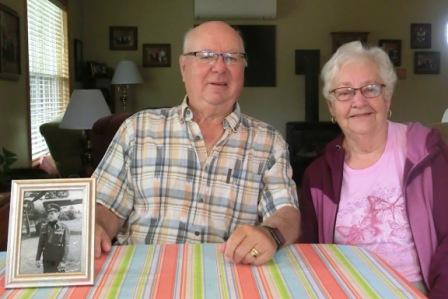
Jim and Fernande MacMacFarlane. (Photo credit: Daria Valkenburg)
Lorne MACFARLANE was born May 23, 1923 in Fernwood, Prince Edward Island, son of Herman and Belle (nee Williams) MacFarlane. “…When he was 18 years old, after graduating from Prince of Wales College in Charlottetown, Lorne enlisted with the RCAF…” Jim explained. Lorne arrived at Manning Depot in Toronto on August 2, 1941. “…He was then posted to Trenton as a security guard and did mostly night duty for 5 to 6 weeks…” RCAF is the Royal Canadian Air Force.
….Lorne began pilot training….
From Trenton, Lorne was posted to the #1 Initial Training School in Toronto for initial training, and then sent for pilot training at No 22 Elementary Flying Training School at Ancienne Lorette outside of Quebec City. “…You needed to be able to distinguish certain colours to be a pilot….” Jim said.
….Lorne’s wings were presented by his father….
From Quebec, Lorne was posted to the No 9 Summerside Flying Training School in Summerside, Prince Edward Island where he learned to fly a Harvard plane. “…My father was also stationed in Summerside, and when Lorne received his wings in May 1942, they allowed my father to present it to him…”
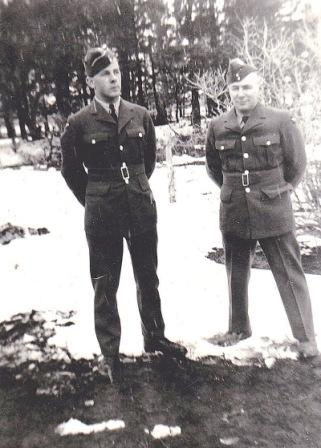
Lorne MacFarlane with his father Herman at their home in Fernwood. (Photo courtesy of Jim MacFarlane Collection)
Lorne was now 19 years old, and two weeks after receiving his wings he was posted back to Trenton. But before he left, Jim chuckled as he recalled that “…Lorne did spins and acrobatics over our house in Fernwood. My mother was pregnant with me at the time….”
Lorne became a flying instructor in Trenton, and then at No 5 Service Flying Training School in Brantford, where he met his future wife, June Turner. From Brantford, Lorne was sent to complete his Operational Training Unit at #34 Pennfield Ridge in New Brunswick. “…While in New Brunswick, Lorne flew over the Island and threw rocks out the window near our home, but up to now, no one has found them….”
In 1943, Lorne went by train to New York City and then travelled to Great Britain aboard the Queen Mary, which had been converted to a troop ship. “…Lorne told me that there were no escort ships, so they were all on watch duty…” Jim said.
Although he had his wings, Lorne was sent to various flight training schools in England to learn skills such as how to fly in smog, and then to #13 Operational Training Unit Finmere Bucks, where he learned to fly the B-25 Mitchell plane. (See https://en.wikipedia.org/wiki/North_American_B-25_Mitchell)
….The first of 40 missions began in May 1944….
He then was assigned to #98 Squadron, Royal Air Force (RAF) in Dunsfold. (See https://en.m.wikipedia.org/wiki/No._98_Squadron_RAF) Lorne’s written account of his service noted that “…My first Operation was on May 19, 1944 as 2nd Pilot…. when we flew a daylight raid on gun positions at Houlgatte. No Flak was encountered…” Houlgatte is in Normany, France.
He was the Captain on his second mission, a day later. This time, and in most of his subsequent flights, he and his crew encountered ‘flak’ – anti-aircraft fire.
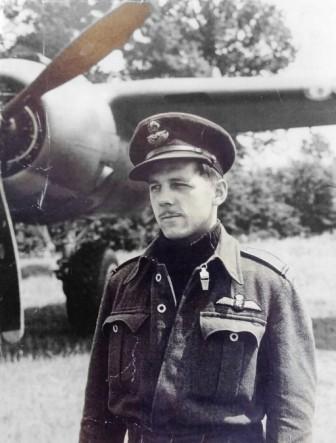
Lorne MacFarlane by his B-25 Mitchell II in Dunsfold, England in 1944. (Photo courtesy of Jim MacFarlane Collection)
….A night mission coincided with D-Day!….
The first 13 missions were flown during the day. His 14th mission, the first done at night, coincided with D-Day – although he and his crew were unaware of it at the time. Lorne’s account recorded that at 2 am on June 6, 1944, with a news reporter identified as Cpl Fairbairn plus eight 500-pound bombs on board, “…our target is a bridge south of Caen over the River Orne. Our flight is two hours and we ran into heavy accurate to light flak at Caen…” Caen is in Normandy, France.
Long after the event, Lorne recounted what happened on that fateful night, and the lucky escape the crew had. “…Our mission was completed and as we crossed the coast on the way back, the enemy seemed to throw everything they had at us. We didn’t even realize it was D-Day – but as we crossed the Channel we could see through breaks in the cloud the wakes of hundreds of ships – so we knew something big was up….”
….Lorne was transferred to Belgium….
Lorne’s next flight was on June 7, so he was not part of the air support for D-Day. He completed his 40th mission on August 12, 1944, and given a much needed leave before his next posting, which began on September 15, 1944 in London, at RAF Station Northolt. From there he was sent to “…2nd Tactical Air Force Communication Squadron, Brussels. We were the first air force to be located here…” The Squadron was based at ‘Evere’, now Haren Airport. (See https://en.wikipedia.org/wiki/Haren_Airport)
Lorne flew a variety of planes and noted that “…our duty was to fly passengers to England, take mail, either pick-up or deliver personnel to the Front Lines – Colonels, Generals, or what have you….”
Among the dignitaries Lorne transported, Pieter found it interesting that Lorne flew Prince Bernhard of The Netherlands to Antwerp. At the time Prince Bernhard was Commander of the Dutch Armed Forces. (See https://en.wikipedia.org/wiki/Prince_Bernhard_of_Lippe-Biesterfeld#Second_World_War)
Lorne was not dropping bombs any longer, but war was still nearby, as per his account of what happened on January 1, 1945. “…While stationed at Evere I experienced the ‘Battle of the Bulge’ for on New Year’s Day our Station was attacked…by the Germans’ last ‘Hurrah’. They attacked our Airfield with many planes and destroyed about everything on the ground. We had a ‘Fighter Squadron’ located on our field and only very few….Spitfires got off the ground – some were shot down as they were taking off…” (See https://en.wikipedia.org/wiki/Battle_of_the_Bulge)
During his time in Brussels, Lorne caught what was believed to be a cold and was hospitalized for a week. When he later was diagnosed with tuberculosis after returning to Canada, he wondered if that hospital stay was where he caught it.
….A new posting in Canada took Lorne back to the Island….
On February 15, 1945 Lorne learned he was on his way back to Canada. “…We sailed on the ‘Louis Pasteur’, arriving in Lachine, Quebec. During my leave I was married….on April 28, 1945, then my posting was to RCAF No 1 Radio and Navigation School in Summerside…”
Between May and October 1945, Lorne was the Officer in Charge. Jim found it ironic that now that Lorne was in charge “…Dad reported to him!…”
Lorne wrote that “…While here I had the chance to take my father on flights as he was in Maintenance and in reality had to check out his own work…”
Lorne was discharged from the RCAF on October 10, 1945 and moved to Ontario, where he and June lived in Burlington. Lorne went into the insurance business. He passed away on February 3, 2004.
Thank you to Jim MacFarlane for contacting us about his brother Lorne, and for sharing photos and stories about his brother’s war service.

With Remembrance Week coming up, please take a look through your photo albums and in your attics in case you have a photo or information to share about Canadian soldiers. There are many more stories still to be told!
Pieter encourages blog readers to contact him if they have a story to share about Canadians who served. You can email him at memorialtrail@gmail.com, comment on the blog, or send a tweet to @researchmemori1.
© Daria Valkenburg
….Want to follow our research?….
If you are reading this posting, but aren’t following our research, you are welcome to do so. Our blog address: https://onthewarmemorialtrail.com/
 4 countries, 6 weeks, 7,000 km – an unforgettable war memorial journey in Europe…. Daria’s book ‘No Soldier Buried Overseas Should Ever Be Forgotten‘ is available in print and e-book formats. Net proceeds of book sales help support research costs and the cost of maintaining this blog. For more information see https://nosoldierforgotten.com/
4 countries, 6 weeks, 7,000 km – an unforgettable war memorial journey in Europe…. Daria’s book ‘No Soldier Buried Overseas Should Ever Be Forgotten‘ is available in print and e-book formats. Net proceeds of book sales help support research costs and the cost of maintaining this blog. For more information see https://nosoldierforgotten.com/

You are also invited to subscribe to our YouTube Channel: On The War Memorial Trail With Pieter Valkenburg: https://www.youtube.com/channel/UCJ591TyjSheOR-Cb_Gs_5Kw.
Never miss a posting! Subscribe below to have each new story from the war memorial trail delivered to your inbox.








 4 countries, 6 weeks, 7,000 km – an unforgettable war memorial journey in Europe….
4 countries, 6 weeks, 7,000 km – an unforgettable war memorial journey in Europe….
